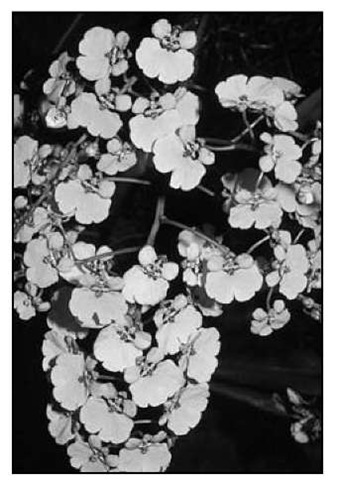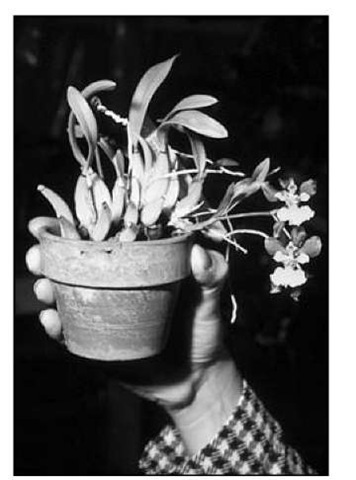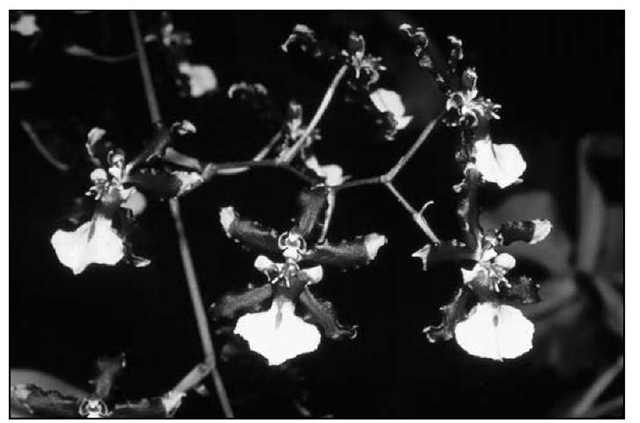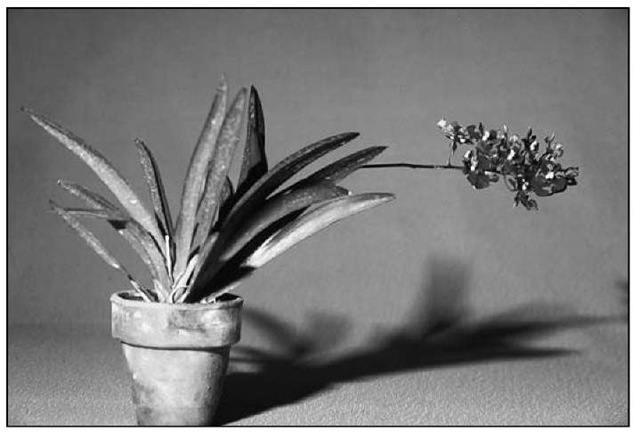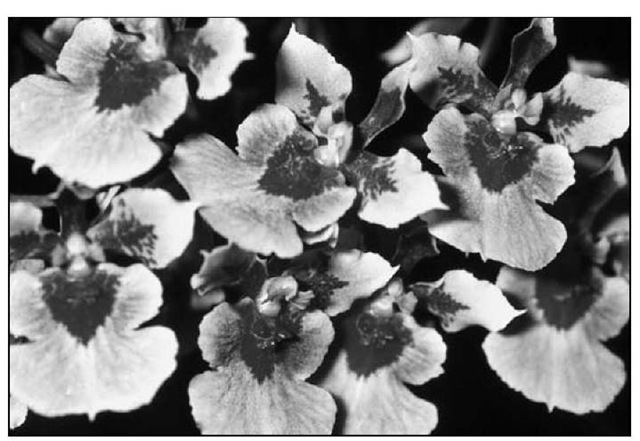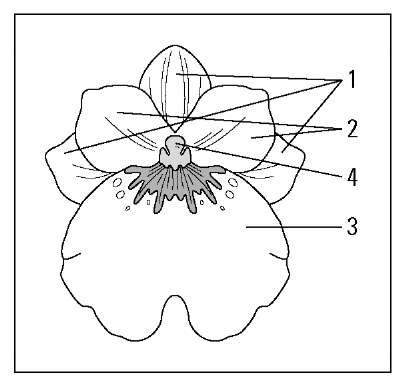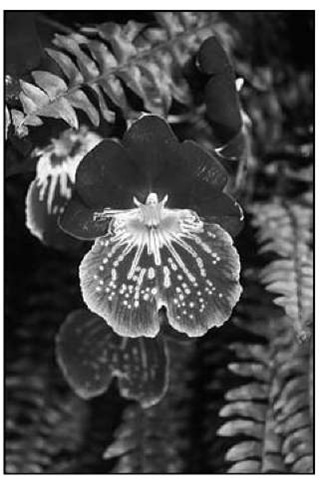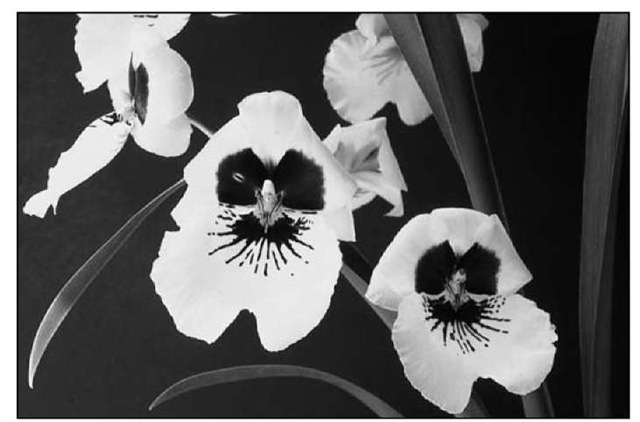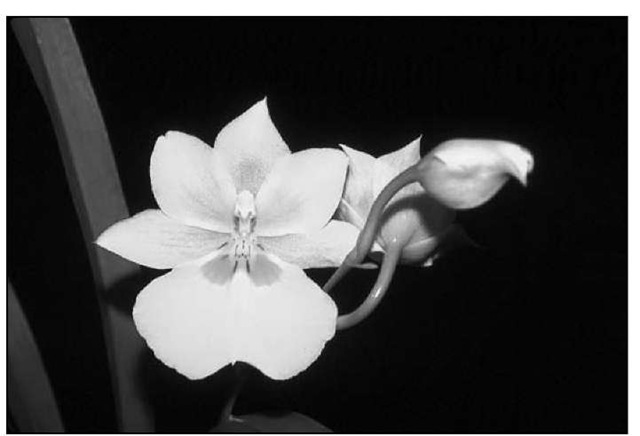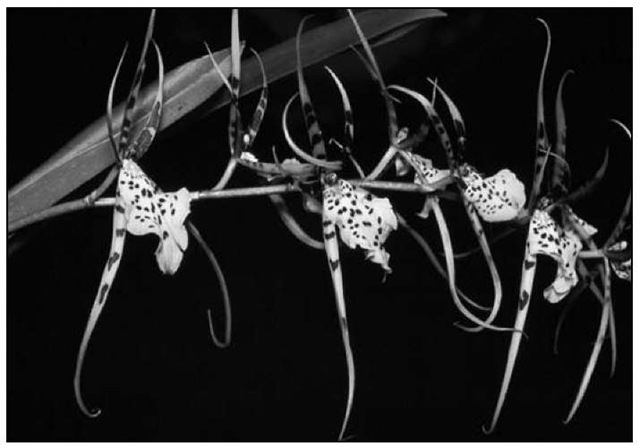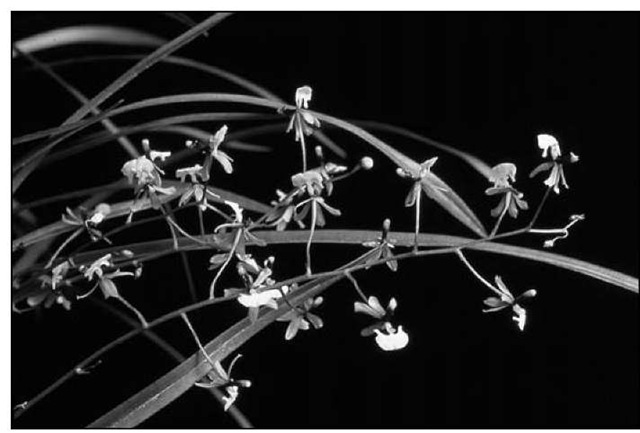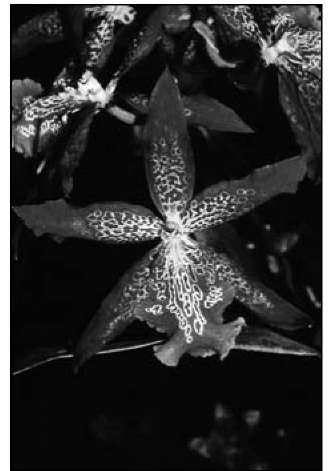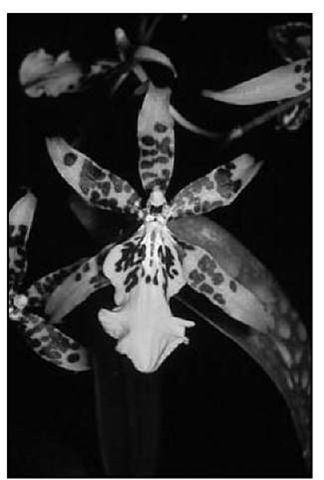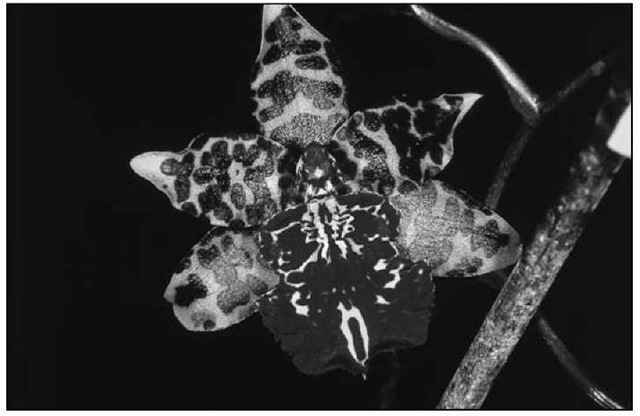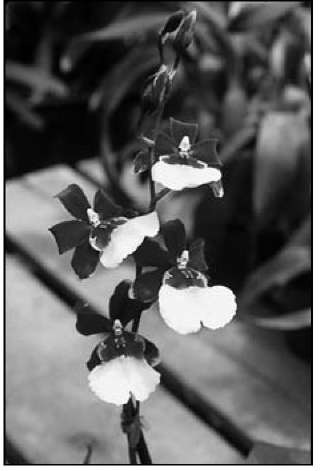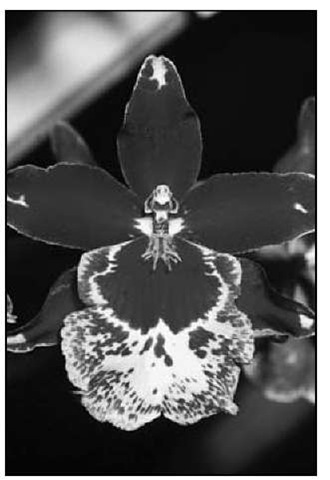In This Topic
- Enjoying sprays of colorful flowers: Oncidiums
- Understanding the pansy orchids: Miltonias and their hybrids
- Knowing the spider orchids: Brassias
- Discovering other Oncidium relatives
This group of orchids is referred to as “dancing ladies” because the lips of many of them are flared like a flounced dancing gown, and the tops of the flowers, with a little imagination, look like the arms and head of a person.
Oncidiums are a joyful bunch of orchids that frequently display a flurry of flowers in the sunny yellow to orange and brown color range, although there are some in shades of pink, red, and green. They’ve been popular since they were first introduced into England from South America in the late 1700s.
Taking a Closer Look at the Ladies
Hundreds of oncidiums are in existence, but just a handful are grown with regularity today. In general, they can be grown in the same conditions as cattleyas.
Oncidiums from the wild
Many oncidiums from the wild are used in producing hybrids (see the following section, “Hybrid oncidiums”). Here are a few species, among the many that are worth looking for:
‘ Oncidium amplicatum (see Figure 13-1): When this orchid is in full bloom in the summer, it displays a shower of 1-inch (2.5-cm) brilliant yellow flowers on sprays up to 4 feet (120 cm) long. The pseudobulbs are short and circular and are sometimes referred to as being turtle-shaped.
‘ Oncidium cheirophorum: This dwarf-growing oncidium (it matures to about 3 inches [7.5 cm]) has /2-inch (1.25-cm) bright yellow citrus-scented flowers on an arching spray.
‘ Oncidium crispum: A quite attractive oncidium with 3-inch (8-cm) rust red flowers and lips with yellow and orange markings on the lips. The flowers are borne on a long spray and its leaves get to be about 6 to 8 inches (15 to 20 cm) long. Its flowers have a musty scent.
‘ Oncidium lanceanum: Referred to as a “mule-leaf” orchid because its stiff leathery foliage takes on this shape, it has flat, long-lasting 2- to 2/2-inch (6-cm) flowers of contrasting brown and yellow with a purple and white lip. The plant grows about a foot (30 cm) tall and has a strong honey scent when the plant is in the sunlight.
‘ Oncidium longipes (see Figure 13-2): A dwarf-growing species from Brazil that blooms in the fall. Its cinnamon scented flowers are % to 1 inch (2 to 3 cm) across with dark yellow to reddish brown sepals and petals and bright yellow lips. It frequently blooms twice a year.
Figure 13-1: Oncidium amplicatum can fill up a windowsill with its shower of flowers.
Figure 13-2: Oncidium longipes is a small-growing plant that is perfect for the windowsill.
Oncidium maculatum: This is a handsome species with 3-inch (8-cm) honey-scented yellow flowers prominently marked with mahogany spots on an arched 20-inch (50-cm) flower spike. It blooms best if it’s grown on the dry side during the winter.
Oncidium onustum (see Figure 13-3): Clear yellow flowers about 1)4 inches (3 cm) wide cover this miniature plant when it’s in bloom in the fall. It likes very bright light and should be grown on the dry side, especially right after flowering.
Figure 13-3: Oncidium onustum is a miniature grower with lemon yellow flowers.
Oncidium ornithorhynchum: This is one of my favorites! It’s a miniature, easy-to-grow, and easy-to-flower orchid and rewards you with scads of /4-inch (1.5-cm) flowers with pink to lavender blooms that have a fresh vanilla fragrance. The plant only grows 8 to 10 inches (20 to 22.5 cm), so it’s perfect for a windowsill or under lights. It frequently blooms a few times a year.
Oncidium splendidum: This oncidium is splendid, indeed. From Guatemala and Honduras, this stately upright flower spike is 3 feet (1 meter) or more and is covered with 2- to 3-inch (5- to 7.5-cm) flowers that feature a broad bright yellow lip. Give this species a bright spot with plenty of growing room and let it dry off during the winter.
Hybrid oncidiums
As is the case with the other orchids mentioned in this topic, there are many hybrids of oncidiums. The orchid breeders have extended the color range and ease of blooming with these hybrids:
Oncidium Sharry Baby (see Figure 13-4): This is one of the most popular orchids in the world! This particular variety outsells all the other orchids. Why? The number-one reason is that it has a very strong fragrance of chocolate or vanilla. It also blooms more than once a year, often around Christmastime. A mature plant has hundreds of /2-inch (1.5-cm) yellow-overlaid-with-burgundy flowers with a flared white lip with purple markings. It’s a bone-tough plant that will grow when others wimp out. My neighbor has one that I gave her and, with very little TLC, it performs dependably every year. This variety is available in many different color forms. As long as you have space for this one (it can grow over 30 inches [75 cm] tall), you can’t go wrong buying one.
Oncidium Twinkles: This is another star performer but with a quite different stature from Sharry Baby. It’s parents, Oncidium cheirophorum and Oncidium ornithrhynchum, both mentioned earlier in this topic, are fragrant and dwarf. The resultant crossing is a hybrid that is even better than its parents — more vigorous and free flowering. This one is highly recommended for beginners. It’s available in various color forms.
Oncidium Tsiku Marguerite: A very vigorous but small-growing (about 6 inches [15 cm] tall) hybrid that is sweet-scented. It produces densely branched sprays of %-inch (2-cm) cream to pink flowers. Another great beginner’s orchid.
Oncidium Nathakhum: This is a larger-growing oncidium with foliage up to about 12 inches (30 cm) long. It shows much influence from one of it parents, Oncidium lanceanum, with its mule-ear foliage and its flat, honey-scented, long-lasting flowers of contrasting brown and yellow with a yellow lip.
Figure 13-4: OncidiumSharry Baby is a fast and easy growing and blooming Oncidium hybrid with the fragrance of chocolate.
Miniature oncidiums or tolumnia
Until fairly recently, the miniature plants that look very much like oncidiums were called equitant (or variegata). Plant taxonomists (people who name plants) are now in a huddle to decide whether or not these plants should be assigned to the genus tolumnia rather than oncidium.
Whatever name you want to call them, they’re darling little plants that are easy to grow. They have triangular thick leaves and are grown best in a sunny spot with good air movement. They’re often mounted on wood or cork but can also be grown in pots. Because they’re small plants in small containers (see Figure 13-5), you must keep an eye on them so they don’t dry out too severely.
Many of these orchids bloom a few times a year and will flower more than once on the same flower spike, so don’t cut off the flower spike until it withers.
So many hybrids are available within this group that choosing one over another is difficult. Just look in the orchid suppliers’ catalogs, on their Web sites, or in their greenhouses in the miniature orchid or miniature oncidium or tolumnia section. They’re all easy growers and prolific bloomers (see Figure 13-6).
Figure 13-5: Equitant oncidiums require little space to grow and bloom. This one is in a 3-inch pot.
Figure 13-6: Even though the equitants are small plants, they have quite a bit of flower power, as this pink and red hybrid proves.
One person’s weed is another’s treasure
Goodale Moir is a well-known name in the annals of orchid breeding. He dared to love a group of oncidiums called equitantsor variegata oncidiums. At the time, in the 1950s, many of his less-enlightened orchid-breeding friends derided these miniatures from the Caribbean as “weeds.” This didn’t stop Goodale from pursuing his dream of breeding and developing these lovelies into small orchids of all colors and shades. While I was working at a botanical garden in Hawaii, in the 1970s, I was fortunate enough to meet him and his lovely wife, May, as his work was starting to be appreciated. Sadly, today, Goodale is no longer with us, but he left behind his proud legacy of these miniature horticultural gems.
Pansy Orchids: Miltonias and Miltoniopsis
To see these orchids in bloom is to want them. True to their name, many of these orchids do have pansylike faces, but they actually outdo the other garden plants with their colors and flower patterns. For some reason, these orchids haven’t gotten their due attention for many years. They had a reputation for being difficult to grow. Most of the newer selections and hybrids are more vigorous, easy, and worth your effort to try.
It used to be that all the orchids in this group were called milto-nias, but now most go by miltoniopsis. For more details on this name game, see the nearby sidebar.
These orchids have a flower structure similar to oncidiums. Figure 13-7 shows the miltonia flower structure.
Here are some guidelines that will help you have more success with these beauties:
Miltonias like it a little warmer than miltoniopsis. Miltonias like it up to about 84°F (29°C) during the day and around 55°F (12.8°C) during the evening. Miltoniopsis like it about 5°F to 10°F cooler for day and night temperatures.
Keep their roots damp but not wet. Their fine root systems can easily be damaged by drying out. The catch-22 is that they can also be very susceptible to rotting if kept too wet. Use a fine-textured, well-drained potting material that also retains moisture.
Figure 13-7: Miltonia flower structure: 1 = Sepals; 2 = Petals; 3 = Lip; 4 = Column.
If the leaves pucker in an accordion pattern, this is a sign the plant is not getting enough moisture.
Keep these plants in small pots. This is an easy way to prevent overwatering.
If the leaves are light green and standing upright, they’re getting just the right amount of light. If they’re floppy and dark green, they’re getting too little light. If they have a reddish cast, they’re getting too much light.
Provide ample air circulation. Otherwise, their thin leaves will get leaf spots from fungal disease.
Miltonias
Here are a few miltonias that are particularly striking and easy to grow:
Miltonia flavescens: The light yellow color of the flower sets this species off from the other miltonias. Its flowers are about 3 inches (7.5 cm) across and have a white lip with red spots.
Miltonia regnellii: This is one of the most adaptable so it’s one of the easiest of the miltonias to grow and bloom. For each erect stem, it has up to six white flowers that are about 2)2 to 3 inches (6 to 7.5 cm) across with a purple-blue lip. It blooms in the summer to fall and has an orangelike fragrance.
Miltonia spectabilis: One of the most popular and commonly offered miltonia species, it displays 4-inch-wide (10-cm-wide) flowers that are white tinged with pink. The lip is rose-pink with a purple column. This orchid grows to about 10 inches (25 cm) high and its flowers have a rosy fragrance. Another botanical variety, Miltonia spectabilis var. moreliana, has flowers of the same size but its sepals and petals are dark plum red with a contrasting large, bright rose-pink lip with darker veins. It is quite a looker!
Miltonia Goodale Moir: A classic variety that is a namesake of a famous orchid breeder who lived in Hawaii, this miltonia hybrid likes warmer growing conditions and bears striking flowers with yellow petals spotted in burgundy and white lips brushed with a purple pink. Miltonia Goodale Moir is still frequently used as a parent to produce other warmth-loving mil-tonia hybrids.
Miltonia Anne Warne: This is another time-proven, warmth-loving hybrid with gorgeous dark purple flowers with stunning purple-pink lips.
Miltoniopsis
Some have said that that miltoniopsis can be more difficult to grow than miltonias, but it really matters which ones you get. Some species like it cooler and others tolerate warmer conditions. The hybrids seem to be very forgiving and easy. Many hybrids have spectacular markings, like the newer one shown in Figure 13-8.
Figure 13-8: A white miltoniopsis hybrid with striking purple markings.
You say miltonia; I say miltoniopsis
The technical difference between these two is that all those orchids called milto-nias have two, light green leaves per pseudobulb and “ears” on the column, in the center part of the flower. Miltoniopsis have one blue-green leaf per pseudobulb. Unless you’re a taxonomist, the flowers look the same.
From a cultural point of view, miltonias are considered by some to be somewhat easier to grow because they’re from Brazil, where it’s warmer, while most of the miltoniopsis are from the cooler climes of Peru, Columbia, and Costa Rica so they can be more temperamental.
Here are some others that should be on your list:
Miltoniopsis phalaenopsis: This species is the one primarily responsible for the “waterfall” patterns in the lips of today’s hybrids. It likes warm summers and cool winters and does best if it’s kept on the dry side during the winter. Its flower, which has the perfume of lily of the valley, is 1% inches (4 cm) and white pansy-shaped with a purple waterfall pattern on the lip. The plant reaches about 6 to 12 inches (15 to 30 cm) high.
Miltoniopsis roezlii: A cool to warm grower, this is another one of the easier-to-grow miltoniopsis. It has 2/2-inch-wide (6.5-cm-wide) white rose-scented flowers with dark-purple spots on each of the petals and a white lip with bright yellow and orange markings. The plant reaches about 9 inches (22 cm) tall.
Miltoniopsis santanaei (see Figure 13-9): This is a very rewarding plant that is easy to grow and flower, which it often does more than once a year. Its flower is 2 inches (5 cm) wide, pristine white, flat, pansy-shaped with a bright yellow flare on the top of the lip. It’s a compact-growing orchid — only 6 to 8 inches (15 to 20 cm) tall. It has a very sweet rose scent and is used frequently in breeding for this fragrant quality and its ease of culture.
Miltoniopsis Bert Field: Pure velvety red, this hybrid’s flowers are about 3 inches (7.5 cm) across. They’re perfectly formed and some have waterfall patterns. It’s a classic variety that is still found and is used often as a parent.
Miltoniopsis Celle ‘Wasserfall’ (see Figure 13-10): There are many new hybrid miltonias, but this was one of the first to show such a spectacular “waterfall” pattern in the lip. Its red velvet sepals and petals and yellow column complete a gorgeous picture. The flowers have a rosy floral scent.
Figure 13-9: Miltoniopsis santanaei is a compact, easy-to-grow species well suited to growing on a windowsill or under lights.
Figure 13-10: Miltoniopsis Celle ‘Wasserfall’ is definitely a showstopper.
Miltoniopsis Hajime Ono: Named after the noted Hawaiian miltoniopsis breeder, Hajime Ono, it has a magnificent 3/2-inch-wide (9-cm-wide) dark-red velvety flower with a lip fantastically marked with a waterfall pattern. See the color section of photographs for an example.
Miltoniopsis Hamburg: This is another famous cross that set the standard for quite a while for being one of the best of the solid reds. It has a light rosy fragrance.
Other Members of the Club: The Oncidium Alliance
Many other orchids are related to oncidiums, and they’re commonly referred to as being part of the Oncidium Alliance. In the following sections, I list some of the more prominent ones.
Orchid spiders: Brassias
Large flowers with long, leggy petals and sepals typify this group of orchids. Although some of the species and hybrids of brassias are popular, they are more commonly used as parents with other oncidium relatives to pass on their elegant flower shapes (see “Mixing It Up,” later in this topic). Here are a few standouts of the 15 or so species of brassias:
Brassia longissima (see Figure 13-11): This orchid features large spidery flowers about 7 to 8 inches (18 to 20 cm) from top to bottom that open greenish and turn orange over several days. The flowers are spotted maroon and have a sweet, candy scent. This is a tall grower that maxes out at about 30 inches (75 cm) tall.
Brassia maculata: A commonly grown species, this orchid also follows the similar flower shape and color pattern of the other two species described in this list. It blooms in the summer and puts on a show of fragrant flowers for several weeks.
Brassia verrucosa: Another spider-type flower that reaches about 6 to 8 inches (15 to 20 cm) across, this orchid is pale green and is spotted in darker green or brown with a white lip spotted with darker warts. This species is an easy one to grow. It has a musky scent.
Butterfly orchids: Psychopsis
This orchid used to be called an oncidium and then was reclassi-fied to this genus. It doesn’t take much imagination to see how this orchid got its common name, butterfly orchid, because the flower looks very much like this regal insect.
Psychopsis papilio (shown in Figure 13-12) is the most popular species in the genus and is an easy one to grow, requiring the same cultural conditions as oncidiums. Psychopsis papilio has reddish leathery leaves with darker spots; its flowers have thin, dark burgundy, upright sepals that look like antennae; the petals are barred dark red on yellow; and the lip is yellow with solid or spotted burgundy red edging. Another species, Psychopsis krameriana, is very similar.
Figure 13-11: Brassia longissima is a fine selection of this species.
The flowers are borne in succession, so don’t cut off the flower spike until it shrivels.
Figure 13-12: Psychopsispapilio has a butterfly look.
Not for beginners
The Oncidium Alliance has other genera — including baptisonia, cochlioda, com-parettia, odontoglossum, rodriguezia, and trichocentrum — but many are not noted for being easy to grow. Some are from cooler climates and require very high humidity. They have, however, played important roles as genetic building blocks to produce hybrids with all the other oncidium group. See the “Mixing It Up” section for more details.
Sigmatostalix
Sigmatostalix radicans (shown in Figure 13-13) is a dainty and charming miniature orchid, reaching about 6 inches (15 cm). It has grasslike foliage and small /4-inch (1 cm) white flowers with greenish sepals and petals with a brown column and white lip. Its flowers have a sweet honey fragrance.
Figure 13-13: Sigmatostalix radicans is a miniature orchid with a honey scent.
Trichopilia
Two orchids within the trichopilia genus are commonly grown:
Trichopilia suavis: A native of Central and South America, this orchid has oblong pseudobulbs with leaves that can grow up to 16 inches (40 cm) long. It’s frequently grown in a basket because the two to five fragrant flowers, white spotted with red, are borne on a pendulous flower spike. The lips of the flowers are tubular and have pink and orange spots.
Trichopilia fragrans: This orchid is very similar to the preceding one and blooms in the spring to summer.
Mixing It Up
Now things really get interesting! Imagine taking all the orchids that I introduce in this topic from the Oncidium Alliance, and many more that I haven’t even mentioned, and mating or breeding them with each other. This is just what has been done by skillful orchid breeders in the United States — and the results have been astounding!
Knowing where to begin is difficult, because there are so many different ones. By the late 1990s, almost 10,000 of these hybrids had been registered and breeding efforts have continued at full tilt, so today there are many more.
In general, these are orchids with wild color combinations and large flower counts that are durable, vigorous plants. These new hybrids are starting to compete with phalaenopsis for the public’s favor.
These hybrids have a scrambled parentage. To help you sort through it all, Table 13-1 is a list of some of the most common and popular intergeneric genera (ones that have parents from more than one genus) along with the genera that were used to actually produce these new intergeneric genera. The abbreviations for the genera are also given, because this will usually be what you’ll find written on the orchid label.
|
Table 13-1 |
Oncidium Alliance Intergenerics |
|
|
Intergeneric Genus |
Genera Used to Create This Genus |
Abbreviation Used |
|
Aliceara |
Brassia, Miltonia, Oncidium |
Alcra. |
|
Beallara |
Brassia, Cochlioda, Miltonia, Odontoglossum |
Bllra. |
|
Brassada |
Ada, Brassia |
Brsa. |
|
Brassidium |
Brassia, Oncidium |
Brsdm. |
|
Table 13-1 |
||
|
Intergeneric Genus |
Genera Used to Create This Genus |
Abbreviation Used |
|
Burrageara |
Cochlioda, Miltonia, Odontoglossum, Oncidium |
Burr. |
|
Colmanara |
Miltonia, Odontoglossum, Oncidium |
Colm. |
|
Degarnoara |
Brassia, Miltonia, Odontoglossum |
Dgmra. |
|
Milpasia |
Miltonia, Aspasia |
Mpsa. |
|
Miltassia |
Brassia, Miltonia |
Mtssa. |
|
Miltonidium |
Miltonia, Oncidium |
Mtdm. |
|
Odontocidium |
Odontoglossum, Oncidium |
Odcm. |
|
Odontonia |
Odontoglossum, Miltonia |
Odtna. |
|
Rodricidium |
Oncidium, Rodriguezia |
Rdcm. |
|
Vuylstekeara |
Cochlioda, Miltonia, Odontoglossum |
Vuyl. |
|
Wilsonara |
Cochlioda, Odontoglossum, Oncidium |
Wils. |
Orchid breeders hybridizing these related orchids are working to impart the following qualities to their plants:
More-compact growth and flowering habit Ease of flowering
- More tolerance for a wide range of growing temperatures Lower light requirements Blooming multiple times per year Bright, colorful patterns in the flowers
- When you visit your orchid grower, check out orchid supplier Web sites, or go to orchid shows, you’ll see that today’s hybrids in this group are moving closer and closer to meeting these breeding objectives.
Because this group is so huge, I’ve tried to hit on some of the most popular in this group. This is only the tip of the iceberg:
Beallara Marfitch ‘Howard’s Dream’ (see Figure 13-14): This orchid has dazzling, large, deep burgundy flowers on upright flower spikes with white markings and a dash of yellow on the lip. These are always the plants people stop to admire at the orchid shows.
‘ Beallara Tacoma Glacier: This is found in various forms but most have very large frilly flowers with red markings.
‘ Brassidium Fly Away ‘Miami’ HCC/AOS (see Figure 13-15): These bright yellow flowers are borne in huge numbers and look like they are taking off in flight.
Figure 13-14: Beallara Marfitch ‘Howard’s Dream’ is always the center of attention when it’s in bloom.
Figure 13-15: The flowers of Brassidium Fly Away ‘Miami’ HCC/AOS have masses of flowers on long flower spikes.
Burrageara Stefan Isler: This orchid has upright stems with many brilliant red flowers with a lighter color lip. It is free flowering and will bloom more than once a year when the plant is mature.
Colmanara Wildcat (see Figure 13-16): There are many different selections of this orchid, but they are all very bright yellow, waxy flowers about 3 inches (7.5 cm) across with very distinct yellow or maroon markings, and a lip that is usually very dark red and marked with yellow. It’s quite a standout.
Figure 13-16: Colmanara Wildcat has dramatic feline markings on a waxy long-lasting flower.
Degarnoara Winter Wonderland ‘White Fantasy’ (see Figure 13-17): Many selections of this orchid are available, but they look very similar. They have large white flowers and lip with sepals that extend slightly backward. The lip and petal are lightly spotted in red. The flower is said to have the fragrance of bananas. An established plant will bloom a few times a year
Milpasia Milt’s Choice ‘Helen of Troy’: Long-lasting yellow with rose to maroon stripes on the petals with a large white lip are the features of this orchid. It grows about 10 to 12 inches (25 to 30 cm) tall and has a rosy fragrance.
Miltassia hybrids: Most of this group are usually strongly marked and brightly colored. See the color section for an example.
Miltonidium Bartley Schwartz (see Figure 13-18): Several different forms of this are available, but most have upright spikes of many red to purple flowers with white lips marked in red.
Figure 13-17: DegarnoaraWinter Wonderland ‘White Fantasy’ has a unique blend of lip shape similar to miltonia, longer petals like brassia, and wider flowers like odontoglossum.
Miltonidium Issaku Nagata ‘Volcano Queen’ HCC/AOS: An easy orchid with many 1/2-inch (4-cm) flowers on tall multi-branched spikes. The petals and sepals are yellow overlaid with mahogany. The flared lip is white at the bottom and red and purple at the top. The foliage can grow 18 to 24 inches (45 to 60 cm) tall and the flowers have a light floral fragrance.
Odontioda Margarete Holm ‘Alpine’: A gorgeous full-bodied white flower with clear burgundy markings. See the color section of photographs for an example.
Odontioda Vespa ‘Charm’ (see Figure 13-19): This is a captivating, very compact orchid that only grows 6 to 8 inches (15 to 20 cm) tall. It displays 2)2-inch (6.5-cm) white, citrus-scented flowers that are decorated with distinct purple and red markings on the petals and sepals with yellow on the throat. I love this one!
Figure 13-18: Miltonidium Bartley Schwartz comes in many forms, but all have many red to purple flowers on an upright flower spike.
Figure 13-19: OdontiodaVespa ‘Charm’ is a favorite because of its compact habit and colorful flower markings.
Odontobrassia Fangtastic Bob Henley: Seventy-five percent of this hybrid’s lineage is from brassias, so it has characteristically spidery yellow flowers that are 4 to 5 inches (10 to 13 cm) across with maroon markings and yellow lips on arching flower spikes.
Odontocidium Crowborough: This hybrid is another one of the earlier crosses that is still available today and is used plenty as a parent for newer hybrids. It has 3-inch (7.5-cm), bright yellow, thick-textured flowers with distinct mahogany markings.
Odontocidium Tiger Crow ‘Golden Girls’ HCC/AOS: An offspring of famous parents, Odontocidium Tiger Hambuhren and Odontocidium Crowborough, it shows off 2/2-inch (6.5-cm) golden-yellow flowers with maroon spots and a bright yellow lip. The plant grows about 18 inches (45 cm) tall and the flowers have a light floral scent. See the color section of photographs for an example.
Vuylstekeara Cambria ‘Plush’ FCC/AOS (see Figure 13-20): This is a classic variety and was one of the first of these inter-generics to hit the market in a big way. Its many flowers are a clear dark red, tipped in white with a red-and-white edge lip. This variety has stood the test of time.
Figure 13-20: Vuylstekeara Cambria ‘Plush’ FCC/AOS has proven itself to be a winner.
Vuylstekeara Yokara ‘Perfection’: This is a dazzler! Its light burgundy flowers sparkle with bright white patterns throughout. A yellow highlight appears on the lip. See the color section for an example.
Wilsonara Tiger Brew: A free flowering and branching plant that has flowers with sepals and petals that are light yellow and spotted with burgundy and a lip that is lemon yellow with reddish spots. The edges of the petals and sepals are touched in red and fringed.
